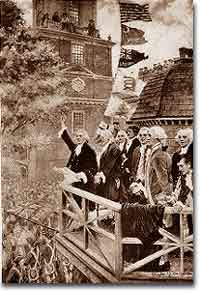

"When in the Course of human events, it becomes necessary for one people to dissolve the political bands which have connected them with another, and to assume among the powers of the earth, the separate and equal station to which the Laws of Nature and of Nature's God entitle them, a decent respect to the opinions of mankind requires that they should declare the causes which impel them to the separation."

The first public reading of the Declaration of Independence occurred at high noon on July 8, 1776, in the Old State House yard in Philadelphia (what is now Independence Hall).
So begins the Declaration of Independence . But what was the Declaration? Why do Americans continue to celebrate its public announcement as the birthday of the United States, July 4, 1776? While that date might just mean a barbecue and fireworks to some today, what did the Declaration mean when it was written in the summer of 1776?
On the one hand, the Declaration was a formal legal document that announced to the world the reasons that led the thirteen colonies to separate from the British Empire. Much of the Declaration sets forth a list of abuses that were blamed on King George III. One charge levied against the King sounds like a Biblical plague: "He has erected a multitude of New Offices, and sent hither swarms of Officers to harrass our people, and eat out their substance."
The Declaration was not only legalistic, but practical too. Americans hoped to get financial or military support from other countries that were traditional enemies of the British. However, these legal and pragmatic purposes, which make up the bulk of the actual document, are not why the Declaration is remembered today as a foremost expression of the ideals of the Revolution.
The Declaration's most famous sentence reads: "We hold these truths to be self-evident, that all men are created equal ; that they are endowed by their Creator with certain unalienable rights; that among these are life, liberty, and the pursuit of happiness." Even today, this inspirational language expresses a profound commitment to human equality.
This ideal of equality has certainly influenced the course of American history. Early women's rights activists at Seneca Falls in 1848 modeled their " Declaration of Sentiments " in precisely the same terms as the Declaration of Independence. "We hold these truths to be self-evident," they said, "that all men and women are created equal." Similarly, the African-American anti-slavery activist David Walker challenged white Americans in 1829 to "See your Declaration Americans. Do you understand your own language?" Walker dared America to live up to its self-proclaimed ideals. If all men were created equal, then why was slavery legal?
The ideal of full human equality has been a major legacy (and ongoing challenge) of the Declaration of Independence. But the signers of 1776 did not have quite that radical an agenda. The possibility for sweeping social changes was certainly discussed in 1776. For instance, Abigail Adams suggested to her husband John Adams that in the "new Code of Laws" that he helped draft at the Continental Congress, he should, "Remember the Ladies, and be more generous and favorable to them." It didn't work out that way.
King George III showed signs of madness. He likely suffered from porphyria, a disease of the blood leading to gout and mental derangement.
Thomas Jefferson provides the classic example of the contradictions of the Revolutionary Era. Although he was the chief author of the Declaration, he also owned slaves, as did many of his fellow signers. They did not see full human equality as a positive social goal. Nevertheless, Jefferson was prepared to criticize slavery much more directly than most of his colleagues. His original draft of the Declaration included a long passage that condemned King George for allowing the slave trade to flourish. This implied criticism of slavery — a central institution in early American society — was deleted by a vote of the Continental Congress before the delegates signed the Declaration.

So what did the signers intend by using such idealistic language? Look at what follows the line, "We hold these truths to be self-evident, that all men are created equal, that they are endowed by their Creator with certain unalienable Rights, that among these are Life, Liberty and the pursuit of Happiness ."
That to secure these rights, Governments are instituted among Men, deriving their just powers from the consent of the governed, That whenever any Form of Government becomes destructive of these ends, it is the Right of the People to alter or to abolish it, and to institute new Government, laying its foundation on such principles and organizing its powers in such form, as to them shall seem most likely to effect their Safety and Happiness.
These lines suggest that the whole purpose of government is to secure the people's rights and that government gets its power from "the consent of the governed ." If that consent is betrayed, then "it is the right of the people to alter or abolish" their government. When the Declaration was written, this was a radical statement. The idea that the people could reject a monarchy (based on the superiority of a king) and replace it with a republican government (based on the consent of the people) was a revolutionary change.
While the signers of the Declaration thought of "the people" more narrowly than we do today, they articulated principles that are still vital markers of American ideals. And while the Declaration did not initially lead to equality for all, it did provide an inspiring start on working toward equality.
The First Draft
Jefferson's first attempt at creating a Declaration of Independence included a passage condemning slavery that was later removed. Read that "original Rough draught" here.
King George III
George III is widely remembered for two things: losing the American colonies and going mad. Not exactly a glowing endorsement from the official site of the British Monarchy, but this biography does concentrate more on King George's strengths than his weaknesses. In addition to the informative bio, you get a great picture of the King and his family, and a link to a letter containing George's thoughts on "the loss of America."
4th of July Celebrations Database
For over 2 centuries, the 4th of July has been a day of celebration throughout America. Need proof? This site provides a comprehensive list of Independence Day events from 1776 to the present. You'll also find detailed accounts of the early celebrations in 1776 and 1777, and an explanation of how the 4th became an "official" holiday.
The Declaration of Independence of the United States of America
While not as flashy as some, this National Archives and Records Administration site on the Declaration is perfect if you like fast access to your information. Highlights include an extra-large image of the original document and a section on the early printing and distribution of the Declaration of Independence.
See your Declaration Americans! Do you understand your own language? We hold these truths to be self evident — that ALL MEN ARE CREATED EQUAL!" — Compare your own language with your cruelties and murders inflicted on our fathers and on us — men who have never given your fathers or you the least provocation!" -from David Walker's Appeal, 1829
Learn More.
Not only was the Declaration of Independence a powerful statement of the colonies desire for freedom, it was well written . Follow this link for a look at the stylistic artistry of the Declaration.
Learn More.